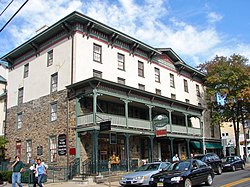
The James W. Marshall House, located at 60 Bridge Street in the city of Lambertville in Hunterdon County, United States, was the boyhood home of James W. Marshall. Marshall's discovery of gold in the American River in California in January 1848 set the stage for the California Gold Rush. The house was added to the National Register of Historic Places on December 18, 1970, for its significance in architecture and history. It now serves as the headquarters for the Lambertville Historical Society, and is open to the public as an historic house museum.
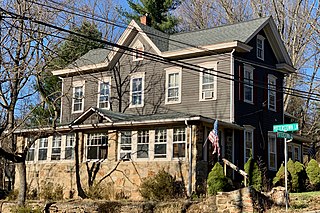
Potterstown is an unincorporated community along the border of Clinton and Readington townships in Hunterdon County, New Jersey.
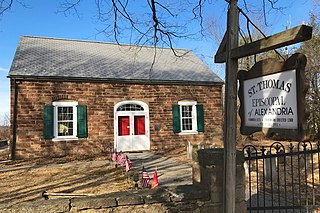
St. Thomas Episcopal Church is a historic church in Alexandria Township in Hunterdon County, New Jersey near Pittstown and is one of the oldest churches in the county. It was added to the National Register of Historic Places on July 21, 1977, for its significance in architecture and religion. The church was featured as a set in Sarah Jessica Parker's movie debut, the 1983 film Somewhere Tomorrow.

The Lambertville Historic District is a 198-acre (80 ha) historic district encompassing the community centered around the intersection of Route 29 and Route 179 in the city of Lambertville in Hunterdon County, New Jersey, United States. The district was added to the National Register of Historic Places on June 30, 1983, for its significance in architecture, commerce, industry, and settlement. It includes 680 contributing buildings, and two contributing structures.
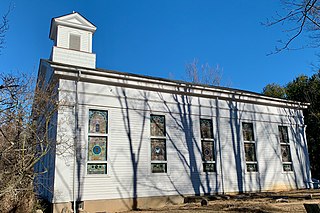
Cokesbury, historically known as Cokesburg, is an unincorporated community located on the border of Clinton and Tewksbury townships in Hunterdon County, New Jersey. It was named after two Methodist bishops, Coke and Asbury. The Cokesbury Historic District was listed on the state and national registers of historic places in 1997.

Sand Brook is an unincorporated community located along County Route 523, Sand Brook-Headquarters & Britton Roads in Delaware Township in Hunterdon County, in the U.S. state of New Jersey.

The Oldwick Historic District is a 170-acre (69 ha) national historic district located along County Route 517, Church, King, James, Joliet and William streets in the Oldwick section of Tewksbury Township in Hunterdon County, New Jersey. The district was added to the National Register of Historic Places on November 14, 1988, for its significance in architecture, commerce, and industry. It includes 127 contributing buildings, 12 contributing structures, and one contributing site. The Kline Farmhouse, listed individually in 1984, also contributes to the district. Many of the buildings were documented by the Historic American Buildings Survey.

Headquarters is an unincorporated community located within the Amwell Valley of Delaware Township in Hunterdon County, New Jersey. The settlement is centered around the intersection of Zentek Road and County Route 604. It is about 3 miles (4.8 km) from Ringoes to the east and 1 mile (1.6 km) from Sergeantsville to the west. The Headquarters Historic District was listed on the state and national registers of historic places in 2011 and had its boundary increased in 2016.

The New Hampton Pony Pratt Truss Bridge is a historic pony Pratt truss bridge on Shoddy Mill Road in New Hampton of Lebanon Township, Hunterdon County, New Jersey. It crosses the Musconetcong River between Lebanon Township, Hunterdon County and Washington Township, Warren County. It was designed by Francis C. Lowthorp and built in 1868 by William Cowin of Lambertville, New Jersey. The bridge was added to the National Register of Historic Places on July 26, 1977 for its significance in engineering, industry and transportation. It is one of the few early examples of iron Pratt truss bridges remaining in the United States. It was later documented by the Historic American Engineering Record in 1991. It was added as a contributing property to the New Hampton Historic District on April 6, 1998.

The Raven Rock Historic District is a 53-acre (21 ha) historic district located along Daniel Bray Highway and Quarry Road in the hamlet of Raven Rock in Delaware Township in Hunterdon County, New Jersey, United States. It was added to the National Register of Historic Places on November 10, 2015, for its significance in architecture and community development. The district includes 15 contributing buildings, 2 contributing sites and 13 contributing structures.

The Thatcher House is a historic brick house located in Kingwood Township, about two miles from Frenchtown, in Hunterdon County, New Jersey. It is named after Jeremiah Thatcher, a local farmer. Built in 1765, the house was added to the National Register of Historic Places on December 4, 2020, for its significance in architecture. It features patterned brickwork with complex diamonds. The house is part of the Traditional Patterned Brickwork Buildings in New Jersey Multiple Property Submission (MPS).

The Old Grandin Library is a historic building located at 12 East Main Street in the town of Clinton in Hunterdon County, New Jersey. It was added to the National Register of Historic Places on November 1, 1974, for its significance in architecture and education. It was built in 1898 as a public library for the town with funds from the estate of Daniel F. Grandin. In 1995, it was also listed as a contributing property of the Clinton Historic District.
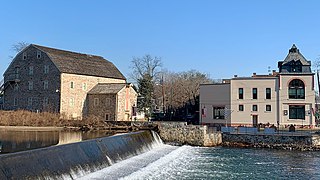
The Clinton Historic District is a 175-acre (71 ha) historic district encompassing much of the town of Clinton in Hunterdon County, New Jersey. It was added to the National Register of Historic Places on September 28, 1995, for its significance in architecture, commerce, engineering, industry and exploration/settlement. The district includes 270 contributing buildings, one contributing structure, and three contributing sites. Five were previously listed on the NRHP individually: Dunham's Mill, M. C. Mulligan & Sons Quarry, Music Hall, Old Grandin Library, and Red Mill.

The John Reading Farmstead is a historic house located at 76 River Road by the South Branch Raritan River in Raritan Township, near Flemington in Hunterdon County, New Jersey. It was built in 1760 for John Reading, former governor of the Province of New Jersey, 1757–1758. The house was added to the National Register of Historic Places on November 21, 1978, for its significance in agriculture, architecture, politics, and exploration/settlement.

The Turner–Chew–Carhart Farm, also known as the Jockey Hollow Farm, is a historic 57-acre (23 ha) farm located off Van Syckles Road in Union Township, Hunterdon County, New Jersey and near Clinton. It was added to the National Register of Historic Places on August 11, 1977, for its significance in agriculture, architecture, industry, and politics/government. The farmstead includes seven contributing buildings.

The J. K. Apgar Farmhouse is a historic stone house located at the intersection of County Route 512 and Guinea Hollow Road in the borough of Califon in Hunterdon County, New Jersey. It was added to the National Register of Historic Places on November 1, 1979, for its significance in architecture.

The District No. 98 Schoolhouse, also known as the Stockton School, is a historic school located at 19 South Main Street in the borough of Stockton in Hunterdon County, New Jersey. It was added to the National Register of Historic Places on January 12, 2005, for its significance in education.

The Kline Farmhouse, also known as Cold Spring Cottage, is located on a 12-acre (4.9 ha) farm along County Route 517, north of Oldwick in Tewksbury Township of Hunterdon County, New Jersey. Built by Jacob Kline in the 1790s, it was added to the National Register of Historic Places on July 11, 1984, for its significance in agriculture, architecture and settlement. Also known as the Beavers House, it was previously documented by the Historic American Buildings Survey in 1966. It was later listed as a contributing property of the Oldwick Historic District in 1988.

The Case Farmstead, also known as the Daniel Case / Sarah Clark Case Farmstead, is a historic 88-acre (36 ha) farm located along County Route 614 near Pattenburg in Union Township, Hunterdon County, New Jersey. It was added to the National Register of Historic Places on August 14, 1979, for its significance in architecture and medicine. The farmstead includes three contributing buildings.
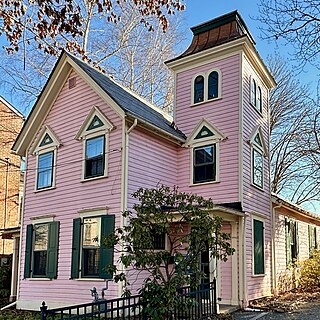
The Kalmia Club is a women's club established in 1892 in the city of Lambertville in Hunterdon County, New Jersey, United States. It has used the house at 39 York Street as its clubhouse since 1893. The Italianate wood-frame house was built around 1870 and expanded in 1882. It was listed as a contributing property of the Lambertville Historic District on June 30, 1983. It was later added individually to the National Register of Historic Places on April 16, 2012, for its significance in education, entertainment, and social history. The Kalmia Club was listed as part of the Clubhouses of New Jersey Women's Clubs Multiple Property Submission (MPS).
